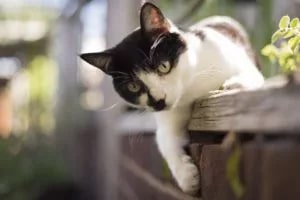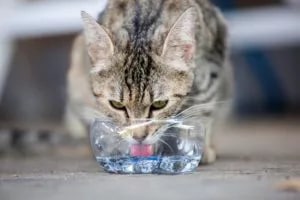Cat Hairballs: What are They, and How Do I Prevent Them?
Cats are pretty cute, but they can also occasionally make their human’s lives a little “hairy” and one of the most common problems that cat owners face is hairballs. Cats groom themselves by licking their fur and swallowing it, which can result in hairballs or mats being formed in their stomachs. This blog post will help you understand why cats have hairballs and how to prevent them so that both you and your furry friend can enjoy each other’s company for many years!

What Is a Cat Hairball?
A hairball is a small collection or ball of fur that forms your cat’s stomach or intestines, usually when they swallow too much loose fur while grooming. Usually, cats vomit hairballs to get rid of the built-up hair in their systems. These hairballs can be anywhere from one inch to five inches in length.
Contrary to popular belief, hairballs actually have more of a tubular, cigar-like shape as opposed to a round, ball-like shape. This shape allows the hairball to pass easily through your cat’s esophagus. Although hairballs primarily contain tight, packed fur, they may also contain bits of swallowed or partially digested food.
Why Do Cats Get Hairballs?
Did you know that, on average, cats can spend up to 50% of their day grooming themselves? Although hairballs are unsightly, they are actually a result of your cat’s normal and healthy grooming habit.
Cat’s tongues have small, hook-like structures, which catch all the dead, loose hair during grooming. This hair is then swallowed along with saliva and the cat’s digestive juices start to break down the proteins in the hair. Normally, all of this excess hair will pass through the digestive system and be eliminated in your cat’s stool.
Occasionally, however, some of that hair will stay in your cat’s stomach and form a hairball. There are several reasons the hair might not be digested and hairballs form.
Take a look at just a few:
- Excessive grooming
- Abnormal digestive tract movements
- Parasites
- Allergies
- Bacteria in the digestive tract
That being said, the occasional hairball isn’t cause to worry. It is a naturally occurring phenomenon in your cat. In fact, there are some breeds of cats that are more likely to experience more frequent hairballs. Among these are many long-haired breeds, or breeds who shed a lot, such as Persians and Maine Coons.
Should I Be Concerned About My Cat Getting Hairballs?
So how do you know when it is time to be concerned about your cat getting hairballs? Like we mentioned, the occasional hairball is usually not a cause for concern. If you notice that your cat is frequently coughing up hairballs, however, something else might be going on.
If your cat is coughing up more hairballs than usual, this could be due to constipation or some other gastrointestinal problem. Additionally, hairballs can indicate allergies or anxiety. You should consult with your Dundee Animal Hospital veterinarian if you notice that there are any abnormalities in the way your cat coughs and if it’s not just an occasional issue.
Other Cat Hairball Symptoms to Watch Out for Include:
- Recurring vomiting, gagging, or retching
- Unproductive cough or hacking
- Loss of appetite
- Lethargy or lack of energy
- Constipation
- Diarrhea
How to Prevent Hairballs
Thankfully, there are several prevention methods to try if your cat is prone to hairballs. Before attempting to treat this issue at home, however, first get advice and discuss treatment options with your vet. This will ensure that your cat gets the best individualized care, possible.
How to Prevent Cat Hairball:
- Help your cat in grooming
Your cat’s regular grooming routine may not be enough, especially if they have long or thick fur. Help your cat by combing their hair every day. You can also use a damp cloth or paper towel to remove any loose, fly-away hairs. This will help make sure your cat doesn’t swallow the extra hairs.
- Use regular flea and tick prevention
Fleas and ticks could lead your cat to excessive scratching and biting. This, in turn, increases the amount of hair the ingest. Ensuring your cat has regular flea and tick prevention not only protects them from these insects but also helps improve their overall health and keep them happy.
- Make sure your cat has plenty of accessible water
Place water bowls throughout your house where your cat regularly likes to drink. Water will help flush out excess hair before it can clump up and form hairballs in your cat’s stomach.
- Adjust feeding habits
There are special cat foods specifically formulated to reduce hairballs. These foods also help to improve your cat’s skin and coat health and reduce the amount of shedding. They also have an increased amount of fiber, which will help your cat’s G.I tract and allow them to easily pass hairballs.
It may also be beneficial to feed your cat smaller amounts of food throughout the day. This type of feeding helps to improve intestinal motility, which can reduce the number of hairballs.
Tips to Help a Cat With a Current Case of a Hairball
- Getting rid of the hairball
If it is a small hairball, you can flush it down the toilet. Otherwise, use an outdoor dumpster or garbage can. Keeping it in your indoor trash can allows the hairball to accumulate more fluids and will increase the foul smell.
2. Soak the stain
Instead of getting to work scrubbing at the area with whatever you have closest to you, spray carpet cleaner on the affected area. Then, leave it to soak for around 5-10 minutes. Doing this allows your cleaning solution to break down the stain and eliminate any odors.
3. Scrub, scrub, scrub
Lastly, scrub the stain with water and a damp cloth. Make sure not to leave any cleaning solution behind. If you notice there is still an odor, you can use vinegar to eliminate any further smells.
A Happy, Hairball-Less Future
Cats are furry creatures and the fur they shed is a natural part of their life. The problem arises when your cat swallows too much hair, resulting in a messy hairball on your floor. If you suspect your cat is having more hairballs than normal, call your vet and set up an appointment. They will likely give your cat a thorough examination and determine if there are underlying causes to the excess of hairballs.



